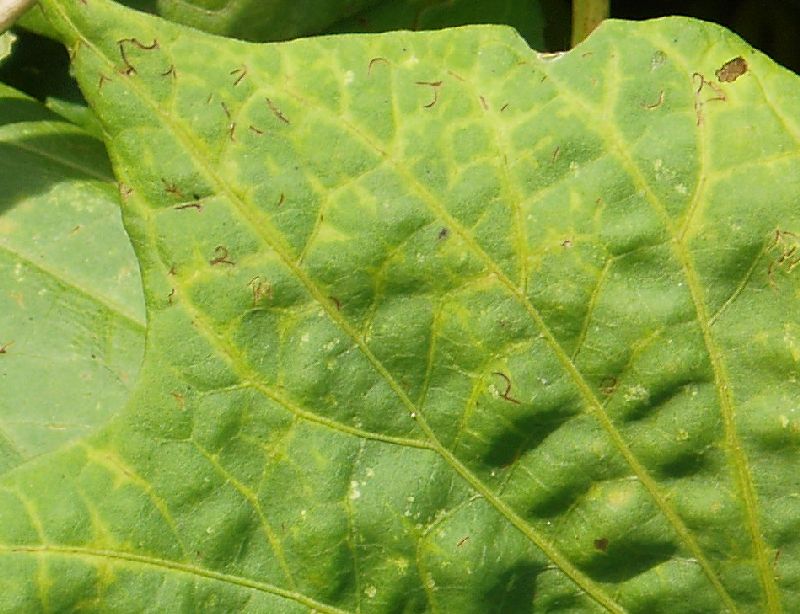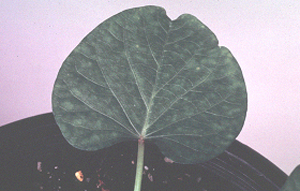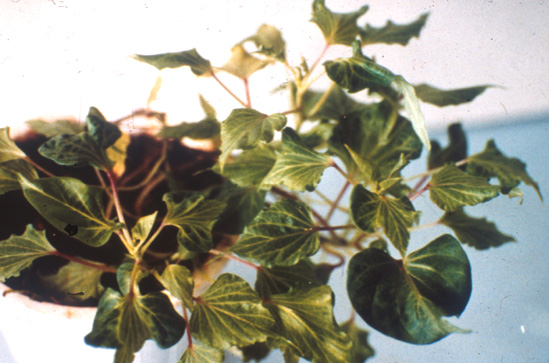|
Viruses are the smallest living things, and they live and multiply inside the
cells of their host. They cause disease in the host by diverting the
host's resources away from its own essential functions, in order to multiply the
virus. They may be concentrated in a particular tissue, such as in the veins,
and hence cause specific symptoms there.
A
large number of viruses can infect sweetpotato. As the crop is
vegetatively propagated, viruses get passed on from one generation to the next.
It is normal for a sweetpotato crop to be infected by several viruses at the
same time. Most viruses cause few if any symptoms when present alone.
Little information is available on their effect on yield, but some depression is
common and will vary with growing conditions. Some combinations of
viruses are particularly harmful - the most significant of these being
Sweetpotato Virus Disease (SPVD).
The economic impact of virus infection is rarely measured, but can be quite
considerable. When virus-free planting material is compared with "normal"
crops, the yields are usually at least 20% greater. In some situations,
and with some cultivars, the yield benefit of virus removal is much greater.
Worldwide. Some viruses have limited geographic distribution.
Often the strain (genotype) of a virus may vary from one place to another.
Symptoms are often not obvious, but a problem may be suspected due to yield
decline over several years. Typical virus symptoms are slower growth,
possibly with paler leaves or interveinal
chlorotic
mottling.
However, these symptoms are often overlooked if there are no uninfected plants
for comparison.
Vein clearing
(paler colour on the leaf veins) or chlorotic spots or ring-spots might be
induced. Some viruses cause deformities in expanding leaves, including
puckering,
"fan-leaf", or curling of margins.
As symptoms are usually mild, they are often unnoticed until most or all
plants are infected, and yield depression is observed. However, where
symptoms are more conspicuous or severe, they will appear on individual plants.
It is difficult to diagnose specific viruses from symptoms alone. A
positive diagnosis is usually achieved through laboratory tests, including
antibody response (serological tests), electron microscopy, and grafting onto a
test host (usually Ipomoea setosa) which may show stronger and more
specific symptoms than sweetpotato.
Most sweetpotato viruses are spread from infected to uninfected plants in
the saliva of sucking insects, such as aphids and whiteflies. Once a cell
is infected, it multiplies the virus and releases virus particles to infect
adjacent cells. Plants do not have an immune system comparable with that
of humans, and generally they can not get rid of the virus. However, they
can suppress its reproduction and spread within the plant to some extent, and
this may vary among cultivars resulting in some virus tolerance.
Within the host, many viruses are concentrated in the phloem cells, in the
vascular tissue of the plant, where they can move fairly freely from one cell to
the next. Outside the phloem they may spread relatively slowly from one cell to another.
Hence the tip of an actively-growing shoot (which does not yet have phloem
cells) is usually free of viruses.
Virus-free plants can be obtained by tissue-culture of these tips (meristem
culture). Usually the plants are grown at a constant high temperature for
some time before harvesting meristems, to suppress viral reproduction.
Most viruses are specific to sweetpotato and its closest relatives.
Within the crop ecosystem, infection sources are usually only other sweetpotato
crops. Most infections are through planting material, from one generation
to the next.
Clean seed programs
Viruses can be removed by heat treatment and meristem culture. This process
usually results in a yield increase of both vines and roots, from 20% to 200%,
depending on the severity of the original virus infestation. The higher yield
may be maintained for several years in the field, before the virus load has
built up again.
A program in China has significantly boosted regional yields by supplying
farmers with clean planting material regularly. Clean seed programs are
also expanding in USA, South Africa and Australia. Such a system is the standard
practice for Irish/white potato production, but is not yet widely used for sweetpotato.
Host plant resistance
Cultivars may vary in either their resistance to infection in the field, or their
tolerance of the infection. However, no immunity is available.
Breeding programs generally do not specifically address virus tolerance, but
field-based selection tends to discard genotypes most sensitive to local virus
strains. Cultivars selected in one area may perform poorly in another, if
different strains of virus are present.
Cultural control
Selection by farmers of symptomless
planting material can help control the most damaging viral diseases.
Traditionally, growers have restored their crop yields by selecting and
propagating from volunteer seedlings within their crops. As the seeds
rarely carry viruses, seedlings often yield well at least for a few years.
This practice has contributed to the rapid diversification of sweetpotato
genotypes in all areas where it is grown.
Clark, C.A. and Moyer, J.W. 1988. Compendium of sweet potato diseases. APS
Press. 74 p.
Schaefers, G.A.
and Terry, E.R. 1976. Insect transmission of sweet potato disease agents in
Nigeria. Phytopathology 66:642-645.
Contributed
by: Jane
O'Sullivan |
Disease
type
Economic
importance
Geographical
distribution
Symptoms
Biology
and ecology
Host
range
Management
References
Fact sheets are available on the following
sweetpotato viruses:
Sweetpotato
caulimo-like virus
Sweetpotato
chlorotic fleck virus
Sweetpotato
chlorotic stunt virus
Sweetpotato
feathery mottle virus
Sweetpotato latent
virus
Sweetpotato mild
mottle virus
Sweetpotato ring
spot virus
Sweetpotato virus
disease

Vein clearing, a common symptom of viruses (J. O'Sullivan).

An indistinct interveinal mottle (S.
Fuentes & L. Salazar).

Viruses may cause leaf deformities, such as fan-leaf, twisting or
curling of leaves (L. Skoglund).
|

